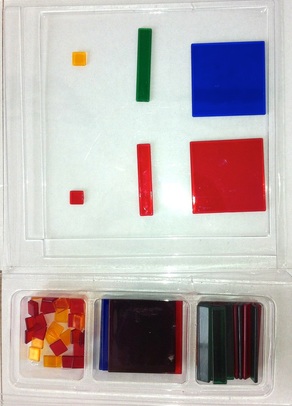Using Area as a Model for Multiplying in Algebra
Activity: Multiples of x

Before using Algebra tiles, it is important to impart to students what each piece stands for.
At first, it's not a bad idea to ask students each time they use the tiles what each tile stands for and why. The whole point of using algebra tiles is that it should connect the models back to ideas of "length times width", and also back to the way students had used base-ten blocks to add and multiply in elementary school. For more information about using base-ten blocks to multiply, see this page, or alternatively, you can visit https://www.youtube.com/watch?v=mjYYbwuued0
- The tiny square (sometimes called a unit) is considered to be a one by one piece, so its area is equal to 1.
- The long piece has a generic length that can vary - so we assign the variable x to the length; since the piece is 1 unit wide and x units long, its area is one by x which equals x.
- The larger square is the same in both dimensions as the "unknown" variable x for the long piece. Therefore, its area is x by x which is x-squared.
- The red pieces are used to model the same values only negative. You will not use the red tiles for this activity.
At first, it's not a bad idea to ask students each time they use the tiles what each tile stands for and why. The whole point of using algebra tiles is that it should connect the models back to ideas of "length times width", and also back to the way students had used base-ten blocks to add and multiply in elementary school. For more information about using base-ten blocks to multiply, see this page, or alternatively, you can visit https://www.youtube.com/watch?v=mjYYbwuued0
How to implement:
This first activity is very basic. You may be tempted to just "direct teach" it to get it done.
I recommend that you do this as a pairs activity, even though it will be very short and introductory. You can follow it up with another more complex activity.
Best if you can use an interactive white board too, but even without, it's a good and engaging start to a lesson.
What I would do: If you have tiles, distribute them. (This can be a student's job - especially if its more or less a regular thing.)
Show one x-tile on the interactive white board. You can also purchase magnetic algebra tiles or even make yourself a set.
Students work in pair to complete the activity (with or without tiles - with is better).
Then after each has made sense of the activity, invite students to come and show their responses on the white board.
The whole thing should take only 20 minutes or so, and you will know they each understand it.
This first activity is very basic. You may be tempted to just "direct teach" it to get it done.
I recommend that you do this as a pairs activity, even though it will be very short and introductory. You can follow it up with another more complex activity.
Best if you can use an interactive white board too, but even without, it's a good and engaging start to a lesson.
What I would do: If you have tiles, distribute them. (This can be a student's job - especially if its more or less a regular thing.)
Show one x-tile on the interactive white board. You can also purchase magnetic algebra tiles or even make yourself a set.
Students work in pair to complete the activity (with or without tiles - with is better).
Then after each has made sense of the activity, invite students to come and show their responses on the white board.
The whole thing should take only 20 minutes or so, and you will know they each understand it.
|
Use these files if you do not have tiles.
|
Use these files if you DO :)
| ||||||||